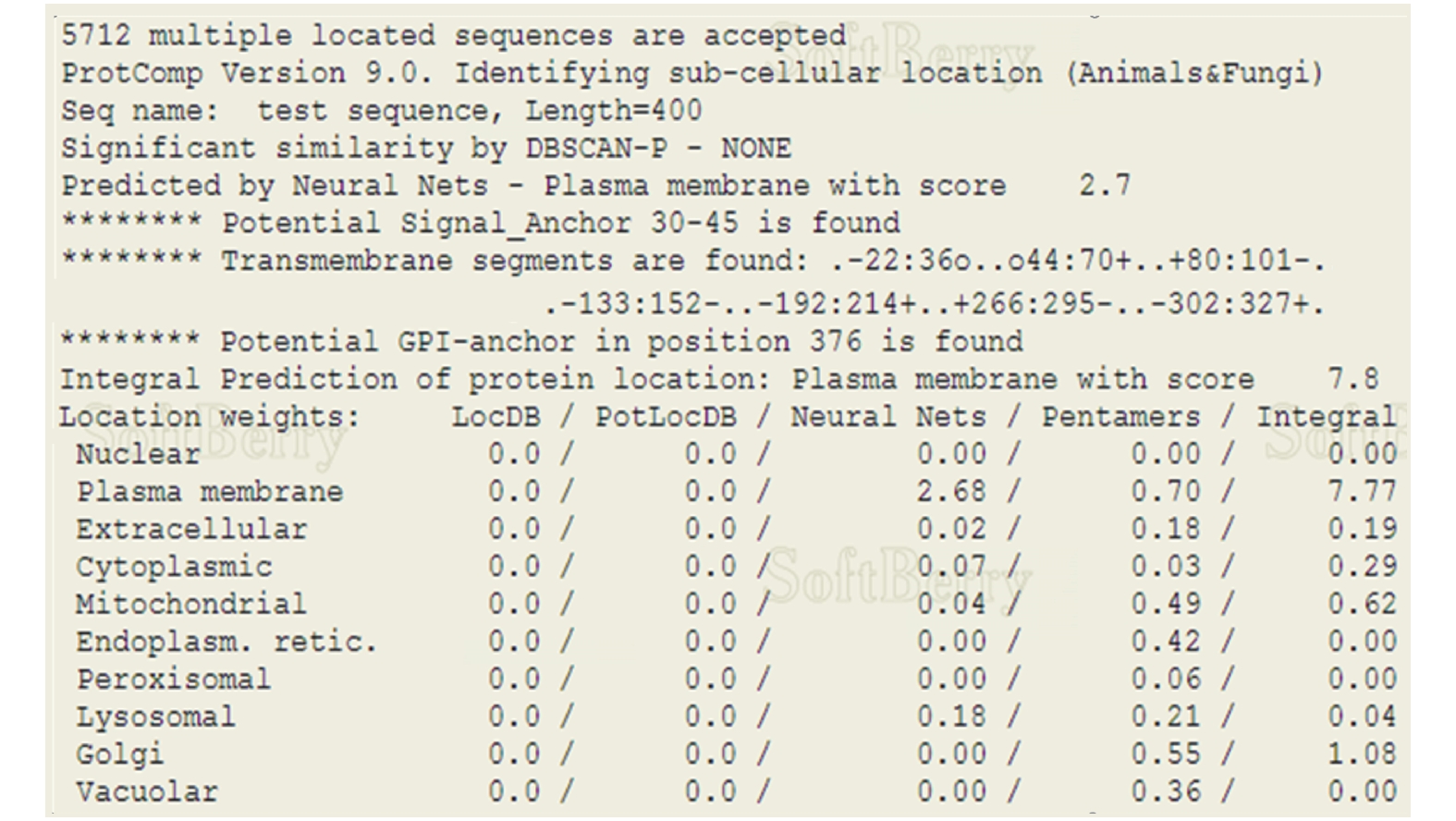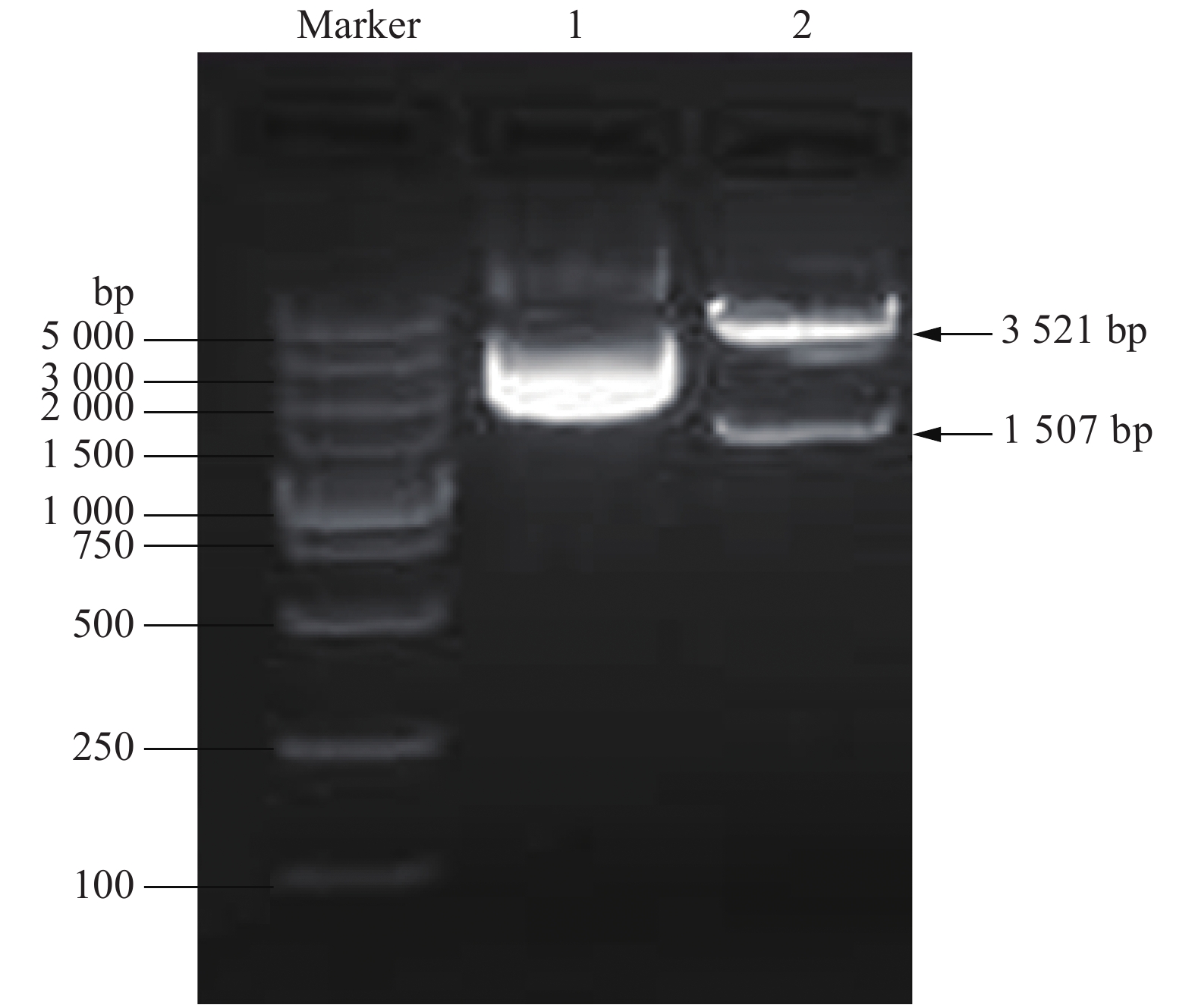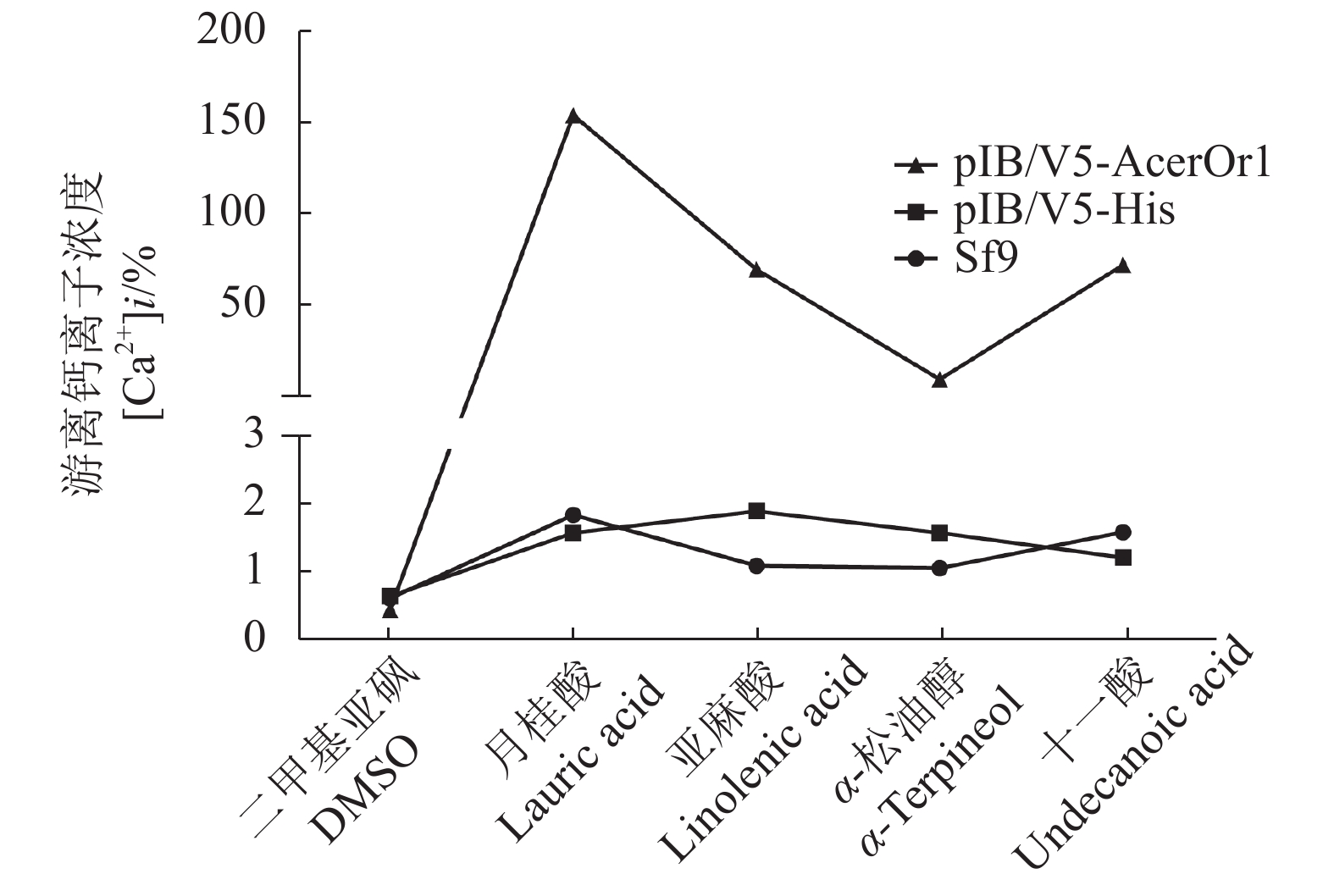Construction and Functions of Expression Vector pIB/V5-His of AcerOr1 in Apis cerana
-
摘要:
目的 构建能在Sf9昆虫细胞中稳定高效表达中华蜜蜂气味受体AcerOr1的重组表达载体,并对其功能进行分析。 方法 将目的基因AcerOr1和昆虫表达载体pIB/V5-His载体用Bam HI和EcoRI做双酶切,通过T4 DNA连接酶构建成含目的基因AcerOr1的表达载体pIB/V5-AcerOr1。将重组表达载体用脂质体转染的方法转染至Sf9细胞中,利用免疫荧光和Western blot检测AcerOr1蛋白的亚细胞定位和表达情况;利用全波长多功能酶标仪检测该受体对4种花香物质刺激后细胞内Ca2+浓度的变化。 结果 成功构建重组表达载体pIB/V5-AcerOr1并建立稳定转染细胞系;Western blot结果证明重组表达载体能在昆虫细胞Sf9中表达;免疫荧光显示重组表达载体在Sf9细胞膜上表达,与预测结果一致。转染pIB/V5-AcerOr1的细胞受花香物质月桂酸(Lauric acid)、亚麻酸(Linolenic acid)、α-松油醇(α-Terpineol)、十一酸(Undecanoic acid)刺激时,均能引起细胞内Ca2+浓度升高。 结论 构建的重组表达载体pIB/V5-AcerOr1能在Sf9细胞中稳定表达,并具有对气味分子的识别功能。 -
关键词:
- 中华蜜蜂 /
- 气味受体AcerOr1 /
- pIB/V5-His /
- 表达 /
- 亚细胞定位 /
- 功能分析
Abstract:Objective To construct and determine the functions of a recombinant expression vector which could stably and efficiently express the olfactory receptor AcerOr1 in Sf9 cells of Apis cerana. Method AcerOr1 was amplified and using T4 DNA ligase ligated into the insect expression vector pIB/V5-His treated by BamHI and EcoRI. The recombinant DNA was liposome-transfected onto Sf9. Subsequently, AcerOr1 expression was determined by Western blot, and protein subcellular localization by immunofluorescence. A full-wavelength multifunctional microplate reader was employed to determine the intracellular Ca2+ concentration before and after the recombinant receptor was stimulated separately with lauric acid, linolenic acid, α–terpineol, and undecanoic acid. Result The recombinant pIB/V5-AcerOr1 was successfully constructed with a stable, transfected vector expression. The recombinant expression vector was determined to be approximately 50 kDa and localized as predicted in the Sf9 cell membrane. The intracellular Ca2+ concentrations in the Sf9 cells transfected with pIB/V5-AcerOr1 increased correspondingly upon the stimulations by the floral substances. Conclusion The recombinant pIB/V5-AcerOr1 was successfully constructed with a stable expression in the Sf9 cell of the bees with the olfactory function verified by exposing the cells to aromatic chemicals. -
Key words:
- Apis cerana /
- olfactory receptor AcerOr1 /
- pIB/V5-His /
- expression /
- subcellular localization /
- function analysis
-
图 5 Western blot检测AcerOr1在Sf9细胞上的表达
注:1:未转染的细胞空白对照;2:转染pIB/V5-His空载体对照;3:转染重组质粒pIB/V5-AcerOr1。
Figure 5. Western blot detection of AcerOr1 expression in Sf9
Note: 1: blank control of non-transfected cell; 2: control of transfected cell with pIB/V5-His empty vector; 3: group of transfected cells with recombinant plasmid pIB/V5-AcerOr1.
表 1 CDS区扩增所用引物
Table 1. Primer for CDS sequencing
基因
Gene引物序列(5′-3′)
Primer sequence(5′-3′)AcerOr1_F CGCGGATCCATGGAAAATACCACGAATTATCGTA AcerOr1_R CCGGAATTCTACCGTCATTGCACGCAGAA 注:下划线标注为酶切位点BamHI和EcoRI。
Note:Underlined sites were enzymatically cleaved by BamHI and EcoRI. -
[1] 申建梅, 胡黎明, 宾淑英, 等. 瓜实蝇嗅觉受体基因的克隆及表达谱分析 [J]. 昆虫学报, 2011, 54(3):265−271.SHEN J M, HU L M, BIN S Y, et al. Cloning and expression profiling of an olfactory receptor gene in Bactrocera cucurbitae (Coquillett) (Diptera: Tephritidae) [J]. Acta Entomologica Sinica, 2011, 54(3): 265−271.(in Chinese) [2] NAUMANN K. Grooming behaviors and the translocation of queen mandibular gland pheromone on worker honey bees (Apis mellifera L) [J]. Apidologie, 1991, 22(5): 523−531. doi: 10.1051/apido:19910505 [3] PARK D, JUNG J W, CHOI B S, et al. Uncovering the novel characteristics of Asian honey bee, Apis cerana, by whole genome sequencing [J]. BMC Genomics, 2015, 16: 1. doi: 10.1186/1471-2164-16-1 [4] WANNER K W, NICHOLS A S, WALDEN K K O, et al. A honey bee odorant receptor for the queen substance 9-oxo-2-decenoic acid [J]. Proceedings of the National Academy of Sciences of the United States of America, 2007, 104(36): 14383−14388. doi: 10.1073/pnas.0705459104 [5] HALLEM E A, DAHANUKAR A, CARLSON J R. Insect odor and taste receptors [J]. Annual Review of Entomology, 2006, 51(1): 113−135. doi: 10.1146/annurev.ento.51.051705.113646 [6] CORCORAN J A, JORDAN M D, CARRAHER C, et al. A novel method to study insect olfactory receptor function using HEK293 cells [J]. Insect Biochemistry and Molecular Biology, 2014, 54: 22−32. doi: 10.1016/j.ibmb.2014.08.005 [7] SATO K, PELLEGRINO M, NAKAGAWA T, et al. Insect olfactory receptors are heteromeric ligand-gated ion channels [J]. Nature, 2008, 452(7190): 1002−1006. doi: 10.1038/nature06850 [8] ZHANG Z X, ZHANG M P, YAN S W, et al. A female-biased odorant receptor from Apolygus lucorum (Meyer-dür) tuned to some plant odors [J]. International Journal of Molecular Sciences, 2016, 17(8): 1165−1175. doi: 10.3390/ijms17081165 [9] SCHNEIDER I. Cell lines derived from late embryonic stages of Drosophila melanogaster [J]. Journal of Embryology and Experimental Morphology, 1972, 27(2): 353−365. [10] JORDAN M D, CHALLISS R A J. Expression of insect olfactory receptors for biosensing on SAW sensors [J]. Procedia Computer Science, 2011, 7: 281−282. doi: 10.1016/j.procs.2011.09.044 [11] HAMANA H, LI S X, BREUILS L, et al. Heterologous functional expression system for odorant receptors [J]. Journal of Neuroscience Methods, 2010, 185(2): 213−220. doi: 10.1016/j.jneumeth.2009.09.024 [12] KIELY A, AUTHIER A, KRALICEK A V, et al. Functional analysis of a Drosophila melanogaster olfactory receptor expressed in Sf9 cells [J]. Journal of Neuroscience Methods, 2007, 159(2): 189−194. doi: 10.1016/j.jneumeth.2006.07.005 [13] KIELY A. Functional and structural analyses of an olfactory receptor from Drosophila melanogaster[D]. Researchspace, 2008. [14] ZHAO H T, GAO P F, ZHANG C X, et al. Molecular identification and expressive characterization of an olfactory Co-receptor gene in the Asian honeybee, Apis cerana cerana [J]. Journal of Insect Science, 2013, 13(80): 1−14. doi: 10.1673/031.013.8001 [15] 孟丽. “细胞膜的功能”一节教学设计 [J]. 生物学通报, 2015, 50(5):35−37.MENG L. Teaching design of the section "Function of Cell Membrane" [J]. Bulletin of Biology, 2015, 50(5): 35−37.(in Chinese) [16] MATARAZZO V, CLOT-FAYBESSE O, MARCET B, et al. Functional characterization of two human olfactory receptors expressed in the baculovirus Sf9 insect cell system [J]. Chemical Senses, 2005, 30(3): 195−207. doi: 10.1093/chemse/bji015 [17] YOU Y W, SMITH D P, LV M, et al. A broadly tuned odorant receptor in neurons of trichoid sensilla in locust, Locusta migratoria [J]. Insect Biochemistry and Molecular Biology, 2016, 79: 66−72. doi: 10.1016/j.ibmb.2016.10.008 [18] LIU Y, LIU C C, LIN K J, et al. Functional specificity of sex pheromone receptors in the cotton bollworm Helicoverpa armigera [J]. PLoS One, 2013, 8(4): e62094. doi: 10.1371/journal.pone.0062094 [19] WANNER K W, NICHOLS A S, ALLEN J E, et al. Sex pheromone receptor specificity in the European corn borer moth, Ostrinia nubilalis [J]. PLoS One, 2010, 5(1): e8685. doi: 10.1371/journal.pone.0008685 [20] MIURA N, NAKAGAWA T, TATSUKI S, et al. A male-specific odorant receptor conserved through the evolution of sex pheromones in Ostrinia moth species [J]. International Journal of Biological Sciences, 2009, 5(4): 319−330. [21] MIURA N, NAKAGAWA T, TOUHARA K, et al. Broadly and narrowly tuned odorant receptors are involved in female sex pheromone reception in Ostrinia moths [J]. Insect Biochemistry and Molecular Biology, 2010, 40(1): 64−73. doi: 10.1016/j.ibmb.2009.12.011 [22] REINHARD J, CLAUDIANOS C. Molecular insights into honey bee brain plasticity[M]. Honeybee Neurobiology and Behavior. Dordrecht: Springer Netherlands, 2011: 359-372. [23] WANG Y, BAKER N, AMDAM G V. RNAi-mediated double gene knockdown and gustatory perception measurement in honey bees (Apis mellifera) [J]. Journal of Visualized Experiments, 2013(77): e50446. doi: 10.3791/50446 -








 下载:
下载:






